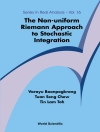Introduction to Logistics Systems Management is the fully revised and enhanced version of the 2004 prize-winning textbook Introduction to Logistics Systems Planning and Control, used in universities around the world.
This textbook offers an introduction to the methodological aspects of logistics systems management and is based on the rich experience of the authors in teaching, research and industrial consulting.
This new edition puts more emphasis on the organizational context in which logistics systems operate and also covers several new models and techniques that have been developed over the past decade.
Each topic is illustrated by a numerical example so that the reader can check his or her understanding of each concept before moving on to the next one. At the end of each chapter, case studies taken from the scientific literature are presented to illustrate the use of quantitative methods for solving complex logistics decision problems. An exhaustive set of exercises is also featured at the end of each chapter.
The book targets an academic as well as a practitioner audience, and is appropriate for advanced undergraduate and graduate courses in logistics and supply chain management, and should also serve as a methodological reference for practitioners in consulting as well as in industry.
Table of Content
Foreword by Marc Goetschalckx xi
Preface xiii
Acknowledgements xv
About the Authors xvii
List of Abbreviations xix
1 Introducing logistics 1
1.1 Definition of logistics 1
1.2 Logistics systems 1
1.3 Reverse logistics 9
1.4 Integrated logistics 10
1.5 Objectives of logistics 12
1.6 Management of the logistics system 18
1.7 Case study: The Pfizer logistics system 33
1.8 Questions and problems 36
2 Forecasting logistics requirements 44
2.1 Introduction 44
2.2 Qualitative methods 46
2.3 Quantitative methods 48
2.4 Data preprocessing 51
2.5 Choice of the forecasting method 59
2.6 Advanced forecasting method 97
2.7 Accuracy measure and forecasting monitoring 98
2.8 Interval forecasts 106
2.9 Case study: Forecasting methods at Adriatica Accumulatori
109
2.10 Case study: Sales forecasting at Orlea 110
2.11 Questions and problems 112
3 Locating facilities in logistics systems 122
3.1 Introduction 122
3.2 Qualitative methods 126
3.3 Quantitative methods 127
3.4 Hybrid methods 174
3.5 Stochastic location models 175
3.6 Case study: Container warehouse location at Hardcastle
179
3.7 Case study: The organ transplantation
location-allocation policy of the Italian National Transplant
Centre 183
3.8 Questions and problems 185
4 Selecting the suppliers 193
4.1 Introduction 193
4.2 Definition of the set of potential suppliers 194
4.3 Definition of the selection criteria 194
4.4 Supplier selection 198
4.5 Case study: The system for the selection of suppliers at
Baxter 202
4.6 Questions and problems 205
5 Managing a warehouse 210
5.1 Introduction 210
5.2 Warehouse design 216
5.3 Tactical decisions for warehouse logistics planning 242
5.4 Operational decisions for warehouse logistics management
276
5.5 Case study: Performance evaluation of an AS/RS system
conducted by Wert Consulting 303
5.6 Case study: Inventory management at Wolferine 305
5.7 Case study: Airplane loading at Fed Ex 306
5.8 Questions and problems 309
6 Managing freight transport 318
6.1 Introduction 318
6.2 Freight Traffic Assignment Problems (TAPs) 326
6.3 Service network design problems 342
6.4 Vehicle allocation problems 350
6.5 A dynamic driver assignment problem 352
6.6 Fleet composition 354
6.7 Shipment consolidation 356
6.8 Vehicle routing problems 359
6.9 Real-time vehicle routing problems 410
6.10 Integrated location and routing problems 412
6.11 Vendor-managed inventory routing 414
6.12 Case study: Air network design at Intexpress 422
6.13 Case study: Meter reader routing and scheduling at Socal
427
6.14 Case study: Dynamic vehicle-dispatching problem with
pickups and deliveries at e Courier 430
6.15 Questions and problems 432
Index 443
About the author
Gianpaolo Ghiani, Università del Salento, Italy
Gilbert Laporte, Canada Research Chair in Distribution Management, Canada
Roberto Musmanno, Università della Calabria, Italy












